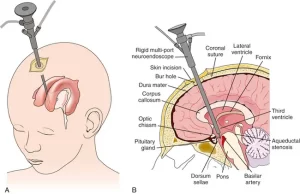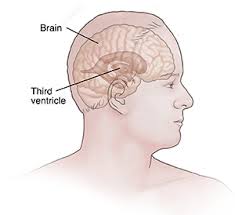
 Ventriculostomy is a neurosurgical procedure that involves creating a hole within a cerebral ventricle for drainage, most commonly for hydrocephalus.
Ventriculostomy is a neurosurgical procedure that involves creating a hole within a cerebral ventricle for drainage, most commonly for hydrocephalus.
It is performed by surgically penetrating the skull, dura mater, and brain such that the ventricular system ventricle of the brain is accessed.
Temporary catheter drainage is commonly referred to as the placement of an external ventricular drain (EVD).
Catheter drainage of a permanent nature is referred to as a shunt.
Catheter-based ventricular shunts that are named for where they terminate, for example, a ventriculi-peritoneal shunt terminates in the peritoneal cavity, and a ventriculoarterial shunt terminates within the atrium of the heart.
The most common entry point on the skull is called Kocher’s point, which is measured 11 cm posterior to the glabella and 3 cm lateral to midline.
An external ventriculostomy is done primarily to monitor the intracranial pressure as well as to drain cerebrospinal fluid (CSF), primarily, or blood to relieve pressure from the central nervous system (CNS).
A ventriculostomy can be created with a hole in the floor of the third ventricle and no indwelling catheter.
